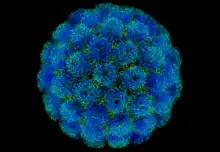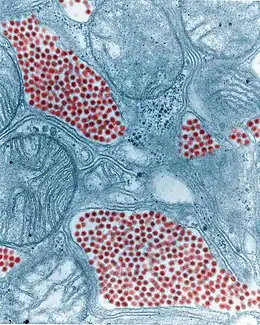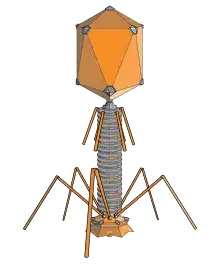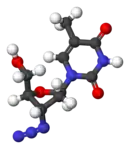The Viruses Portal
Welcome!

Viruses are small infectious agents that can replicate only inside the living cells of an organism. Viruses infect all forms of life, including animals, plants, fungi, bacteria and archaea. They are found in almost every ecosystem on Earth and are the most abundant type of biological entity, with millions of different types, although only about 6,000 viruses have been described in detail. Some viruses cause disease in humans, and others are responsible for economically important diseases of livestock and crops.
Virus particles (known as virions) consist of genetic material, which can be either DNA or RNA, wrapped in a protein coat called the capsid; some viruses also have an outer lipid envelope. The capsid can take simple helical or icosahedral forms, or more complex structures. The average virus is about 1/100 the size of the average bacterium, and most are too small to be seen directly with an optical microscope.
The origins of viruses are unclear: some may have evolved from plasmids, others from bacteria. Viruses are sometimes considered to be a life form, because they carry genetic material, reproduce and evolve through natural selection. However they lack key characteristics (such as cell structure) that are generally considered necessary to count as life. Because they possess some but not all such qualities, viruses have been described as "organisms at the edge of life".
Selected disease

Hepatitis C is an infectious disease affecting mainly the liver, caused by hepatitis C virus (HCV), an RNA virus of the Flaviviridae family which only infects humans and chimpanzees. A "non-A non-B hepatitis" was postulated in the 1970s, and HCV was demonstrated in 1989. HCV is spread primarily by blood-to-blood contact associated with intravenous drug use in the developed world, and with improperly sterilised medical equipment and blood transfusions in the developing world. In about 80% of those infected, the virus establishes a chronic infection in the liver, and around 10–30% of those infected will develop cirrhosis over 30 years. Some people with cirrhosis go on to develop liver failure, liver cancer or other serious complications.
An estimated 143 million people worldwide (2%) have chronic HCV infections as of 2015. The prevalence is highest in Central and East Asia, North Africa and the Middle East. The virus causes around a quarter of cases of cirrhosis and hepatocellular carcinoma, and is a major reason for liver transplantation. The recommended therapy is an appropriate combination of protease inhibitors. Although 95% of people treated in this way are cured, the treatments are expensive and older therapies are less effective. No vaccine against hepatitis C is available.
Selected image

Eastern equine encephalitis virus is an Alphavirus that is transmitted between birds and mammals, including humans and horses, by several mosquito species. The virus (coloured in red) is found in the mosquito salivary gland, and is injected into the new host when the insect feeds.
Credit: Fred Murphy, Sylvia Whitfield, CDC (1968)
In the news

26 February: In the ongoing pandemic of severe acute respiratory syndrome coronavirus 2 (SARS-CoV-2), more than 110 million confirmed cases, including 2.5 million deaths, have been documented globally since the outbreak began in December 2019. WHO
18 February: Seven asymptomatic cases of avian influenza A subtype H5N8, the first documented H5N8 cases in humans, are reported in Astrakhan Oblast, Russia, after more than 100,0000 hens died on a poultry farm in December. WHO
14 February: Seven cases of Ebola virus disease are reported in Gouécké, south-east Guinea. WHO
7 February: A case of Ebola virus disease is detected in North Kivu Province of the Democratic Republic of the Congo. WHO
4 February: An outbreak of Rift Valley fever is ongoing in Kenya, with 32 human cases, including 11 deaths, since the outbreak started in November. WHO
21 November: The US Food and Drug Administration (FDA) gives emergency-use authorisation to casirivimab/imdevimab, a combination monoclonal antibody (mAb) therapy for non-hospitalised people twelve years and over with mild-to-moderate COVID-19, after granting emergency-use authorisation to the single mAb bamlanivimab earlier in the month. FDA 1, 2
18 November: The outbreak of Ebola virus disease in Équateur Province, Democratic Republic of the Congo, which started in June, has been declared over; a total of 130 cases were recorded, with 55 deaths. UN
Selected article

Bacteriophages (or phages) are a large and diverse group of viruses that infect bacteria and archaea. Their genome, which they inject into the host's cytoplasm, can be DNA or RNA, single or double stranded, linear or circular, and contains between four and several hundred genes. Their capsid can be relatively simple or elaborate in structure, and in a few groups is surrounded by an envelope. Caudovirales, double-stranded DNA phages with tails, is the best-studied group, and includes T4 (pictured), λ phage and Mu phage.
Among the most common entities in the biosphere, bacteriophages are ubiquitous in locations populated by bacteria. One of the densest natural sources is sea water, where up to 900 million virions/mL have been found in microbial mats at the surface, and up to 70% of marine bacteria can be infected.
Used as an alternative to antibiotics for over 90 years, phages might offer a potential therapy against multi-drug-resistant bacteria.
Selected outbreak

The 1993 hantavirus outbreak in the Four Corners region of southwest USA was of a novel hantavirus, subsequently named Sin Nombre virus. It caused the previously unrecognised hantavirus pulmonary syndrome – the first time that a hantavirus had been associated with respiratory symptoms. Mild flu-like symptoms were followed by the sudden onset of pulmonary oedema, which was fatal in half of those affected. A total of 24 cases were reported in April–May 1993, with many of those affected being from the Navajo Nation territory. Hantavirus infection of humans generally occurs by inhaling aerosolised urine and faeces of rodents, in this case the deer mouse (Peromyscus; pictured).
Previously documented hantavirus disease had been confined to Asia and Europe, and these were the first human cases to be recognised in the USA. Subsequent investigation revealed undiagnosed cases dating back to 1959, and Navajo people recalled similar outbreaks in 1918, 1933 and 1934.
Selected quotation
| “ | To help conceptualize the sheer number of viruses in existence, their current biomass has been estimated to equal that of 75 million blue whales (approximately 200 million tonnes) and, if placed end to end, the collective length of their virions would span 65 galaxies. | ” |
—Peter Simmonds
Recommended articles
Viruses & Subviral agents: bat virome • elephant endotheliotropic herpesvirus • HIV • introduction to viruses![]() • Playa de Oro virus • poliovirus • prion • rotavirus
• Playa de Oro virus • poliovirus • prion • rotavirus![]() • virus
• virus![]()
Diseases: colony collapse disorder • common cold • croup • dengue fever![]() • gastroenteritis • Guillain–Barré syndrome • hepatitis B • hepatitis C • hepatitis E • herpes simplex • HIV/AIDS • influenza
• gastroenteritis • Guillain–Barré syndrome • hepatitis B • hepatitis C • hepatitis E • herpes simplex • HIV/AIDS • influenza![]() • meningitis
• meningitis![]() • myxomatosis • polio
• myxomatosis • polio![]() • pneumonia • shingles • smallpox
• pneumonia • shingles • smallpox
Epidemiology & Interventions: 2007 Bernard Matthews H5N1 outbreak • Coalition for Epidemic Preparedness Innovations • Disease X • 2009 flu pandemic • HIV/AIDS in Malawi • polio vaccine • Spanish flu • West African Ebola virus epidemic
Virus–Host interactions: antibody • host • immune system![]() • parasitism • RNA interference
• parasitism • RNA interference![]()
Methodology: metagenomics
Social & Media: And the Band Played On • Contagion • "Flu Season" • Frank's Cock![]() • Race Against Time: Searching for Hope in AIDS-Ravaged Africa
• Race Against Time: Searching for Hope in AIDS-Ravaged Africa![]() • social history of viruses
• social history of viruses![]() • "Steve Burdick" • "The Time Is Now" • "What Lies Below"
• "Steve Burdick" • "The Time Is Now" • "What Lies Below"
People: Brownie Mary • Macfarlane Burnet![]() • Bobbi Campbell • Aniru Conteh • people with hepatitis C
• Bobbi Campbell • Aniru Conteh • people with hepatitis C![]() • HIV-positive people
• HIV-positive people![]() • Bette Korber • Henrietta Lacks • Linda Laubenstein • Barbara McClintock
• Bette Korber • Henrietta Lacks • Linda Laubenstein • Barbara McClintock![]() • poliomyelitis survivors
• poliomyelitis survivors![]() • Joseph Sonnabend • Eli Todd • Ryan White
• Joseph Sonnabend • Eli Todd • Ryan White![]()
Selected virus

Noroviruses are a genus of non-enveloped, single-stranded RNA viruses in the family Caliciviridae. The positive-sense RNA genome is approximately 7500 nucleotides long. Known noroviruses fall into five different genogroups (GI–GV); three groups infect humans, the other two mice, and cattle and other bovines. All are considered strains of a single species, Norwalk virus.
Noroviruses are extremely contagious, with fewer than 20 virus particles being infectious. They are transmitted directly from person to person and indirectly via contaminated water and food. After infection, the virus replicates in the small intestine, causing acute gastroenteritis, which develops 12–48 hours after exposure and lasts for 24–72 hours. The characteristic symptoms include nausea, forceful vomiting, watery diarrhoea and abdominal pain. Infection is usually self-limiting and rarely severe. Noroviruses cause 18% of acute gastroenteritis episodes in humans, with around 685 million cases and 200,000 deaths every year, mainly in very young, elderly or immunosuppressed people. No vaccine is available. Hand washing with soap and water is effective in reducing transmission.
Did you know?

- ...that in 1974, Rudolf Jaenisch and Beatrice Mintz created the first transgenic mouse (example pictured) by injecting DNA from simian virus 40?
- ...that double-stranded RNA viruses cause everything from gastroenteritis in young children to bluetongue disease in livestock?
- ...that Inventing the AIDS Virus, written by molecular biologist Peter Duesberg, argues that AIDS is not infectious and that HIV is an unrelated passenger virus?
- ...that proteins from pokeweed have shown antiviral properties?
- ...that Gabriel Scally of the Independent SAGE committee has described the British government's response to the COVID-19 pandemic as "too little, too late, too flawed"?
Selected biography
Randy Shilts (8 August 1951 – 17 February 1994) was an American journalist, author and AIDS activist. The first openly gay reporter for a mainstream US newspaper, Shilts covered the unfolding story of AIDS and its medical, social, and political ramifications from the first reports of the disease in 1981. New York University's journalism department later ranked his 1981–85 AIDS reporting in the top fifty works of American journalism of the 20th century. His extensively researched account of the early days of the epidemic in the US, And the Band Played On Politics, People, and the AIDS Epidemic, first published in 1987, brought him national fame. The book won the Stonewall Book Award and was made into an award-winning film. Shilts saw himself as a literary journalist in the tradition of Truman Capote and Norman Mailer. His writing has a powerful narrative drive and interweaves personal stories with political and social reporting.
He received the 1988 Outstanding Author award from the American Society of Journalists and Authors, the 1990 Mather Lectureship at Harvard University, and the 1993 Lifetime Achievement Award from the National Lesbian and Gay Journalists' Association. He died of AIDS in 1994.
In this month

1 January 1934: Discovery of mumps virus by Claud Johnson and Ernest Goodpasture
1 January 1942: Publication of George Hirst's paper on the haemagglutination assay
1 January 1967: Start of WHO intensified eradication campaign for smallpox (vaccination kit pictured)
3 January 1938: Foundation of March of Dimes, to raise money for polio
6 January 2011: Andrew Wakefield's paper linking the MMR vaccine with autism described as "fraudulent" by the BMJ
25 January 1988: Foundation of the International AIDS Society
29 January 1981: Influenza haemagglutinin structure published by Ian Wilson, John Skehel and Don Wiley, the first viral membrane protein whose structure was solved
Selected intervention

Zidovudine (ZDV) (also known as AZT and sold as Retrovir) is an antiretroviral drug used in the prevention and treatment of HIV/AIDS. Classed as a nucleoside analogue reverse-transcriptase inhibitor, it inhibits HIV's reverse transcriptase enzyme, which copies the viral RNA into DNA and is essential for its replication. The first breakthrough in AIDS therapy, ZDV was licensed in 1987. While it significantly reduces HIV replication, leading to some clinical and immunological benefits, when used alone ZDV does not completely stop replication, allowing the virus to become resistant to it. The drug is therefore used together with other anti-HIV drugs in combination therapy called highly active antiretroviral therapy. To simplify its administration, ZDV is included in combination pills with lamivudine (Combivir) and lamivudine plus abacavir (Trizivir). ZDV continues to be used to prevent HIV transmission from mother to child during childbirth; it was previously part of the standard post-exposure prophylaxis after needlestick injury.
Subcategories
Subcategories of virology:
Topics
Things to do
- Comment on what you like and dislike about this portal
- Join the Viruses WikiProject
- Tag articles on viruses and virology with the project banner by adding {{WikiProject Viruses}} to the talk page
- Assess unassessed articles against the project standards
- Create requested pages: red-linked viruses | red-linked virus genera
- Expand a virus stub into a full article, adding images, citations, references and taxoboxes, following the project guidelines
- Create a new article (or expand an old one 5-fold) and nominate it for the main page Did You Know? section
- Improve a B-class article and nominate it for Good Article
 or Featured Article
or Featured Article status
status - Suggest articles, pictures, interesting facts, events and news to be featured here on the portal
WikiProjects & Portals
 WikiProject Viruses
Related WikiProjects
WikiProject Viruses
Related WikiProjects
Medicine • Microbiology • Molecular & Cellular Biology • Veterinary Medicine
Related PortalsAssociated Wikimedia
The following Wikimedia Foundation sister projects provide more on this subject:
-
 Commons
Commons
Free media repository -
 Wikibooks
Wikibooks
Free textbooks and manuals -
 Wikidata
Wikidata
Free knowledge base -
 Wikinews
Wikinews
Free-content news -
 Wikiquote
Wikiquote
Collection of quotations -
 Wikisource
Wikisource
Free-content library -
 Wikispecies
Wikispecies
Directory of species -
 Wikiversity
Wikiversity
Free learning tools -
 Wiktionary
Wiktionary
Dictionary and thesaurus